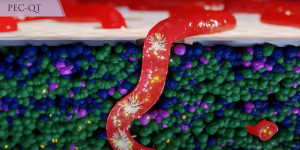
Can a gene-edited cell replacement therapy someday restore insulin in people with type 1 diabetes?
The therapy’s co-developers, ViaCyte, and CRISPR Therapeutics, have begun clinical studies to find out. The companies recently dosed the first patient in their Phase I trial (NCT05210530), designed to evaluate VCTX210 for safety, tolerability, and immune evasion.
“Patient enrollment is ongoing, though we will not be commenting on timing of expected milestones at this stage,” Howard Foyt, MD, PhD, ViaCyte’s Chief Medical Officer, told GEN Edge.
However, CRISPR Therapeutics CEO Samarth Kulkarni said during a fireside chat at SVB Leerink’s 11th Annual Global Healthcare conference, held last month, that data from the study is expected either this year or early next year.
“It will likely take time to generate the initial clinical dataset for VCTX210 (w/ partner ViaCyte) since the company is aiming to accrue 3–6 months of patient follow up for a total of 3–5 patients to generate an interpretable clinical dataset,” Rick Bienkowski, PhD, a vice president, equity research with SVB Leerink focused on genetic medicines, wrote in a February 16 research note.
Beyond safety, Bienkowski wrote, Kulkarni and CRISPR Therapeutics are seeking to answer two key questions in the initial dataset beyond safety.
“First, they would like to understand how well the implanted cells can evade immune system, find their niche, multiply, and differentiate fully. Secondly, understanding if the cells can correctly produce insulin to regulate glucose is a second key question,” Bienkowski added. “Given the nature of the cells that are implanted, it is expected to take some time for cells to differentiate fully.”
VCTX210 (formerly PEC-QT™) is an investigational allogeneic, gene-edited, immune-evasive, stem cell-derived therapy for treatment of type 1 diabetes. VCTX210 is designed to engineer ViaCyte’s CyT49 pluripotent human stem cell line via CRISPR Therapeutics’ gene editing technology to avoid destruction by the patient’s immune system, potentially eliminating the need for chronic immunosuppressants.
The cell line will be differentiated into pancreatic endoderm cells, which will be housed in the same type of device used in ViaCyte’s Phase II candidate PEC-Direct™ (VC-02), allowing for direct interaction between blood vessels and implanted cells.
“The gene-edited cells developed through our collaboration with CRISPR Therapeutics are designed to avoid recognition by the immune system, and therefore the need for concurrent immunosuppression,” Foyt explained. “If successful, the immune-evasive cells could potentially be used to treat both type 1 diabetes and insulin-requiring type 2 diabetes.”
If VCTX210 is found to be safe and immune evasive, the trial may expand to assess therapeutic dosing. The current trial is designed for an estimated enrollment of 10 patients.
The companies are co-developing VCTX210 through a collaboration that was formed in 2018 and generated $15 million in upfront cash for ViaCyte, which has the option under certain circumstances to receive an additional $10 million from CRISPR Therapeutics in the form of a convertible promissory note.
CRISPR Therapeutics and ViaCyte are not disclosing the specific number of products the companies plan to co-develop.
Headquartered in San Diego, ViaCyte is developing a portfolio of stem-cell derived therapies that includes first-in-category, first-in-class products intended to advance a functional cure for type 1 diabetes (T1D) and other chronic diseases.
Replacing insulin
A.M. James Shapiro, MD, PhD, a clinical investigator in the Phase I trial for VCTX210 and Canada Research Chair, Director of the Islet Transplant Program at the University of Alberta, told GEN Edge that while the Phase 1 trial of VCTX210 focuses on safety, tolerability and immune evasiveness, insulin replacement remains the ultimate goal.

“We would want to deploy sufficient numbers of these cells to a patient with diabetes, so they have normal endocrine reserve and no longer require [exogenous] insulin,” Shapiro said. “Diabetes is a biological disease, and it needs a biological solution. We’ve had insulin as a chemical therapy for over 100 years.”
Shapiro led the clinical team that developed the Edmonton Protocol, which relies on multiple donors to generate sufficient numbers of islet cells that are transplanted into the liver, along with a combination of immunosuppressive anti-rejection drugs. In 1999, seven people who received the transplantation procedure “remained free of the need for exogenous insulin” a year later (though they were not cured), according to a landmark study published in 2000 in The New England Journal of Medicine.
“It has been very effective, but the barrier for the [Edmonton] Protocols has been the need for these powerful anti-rejection drugs,” Shapiro said. “They have side effects that can increase the risk of cancers. They can be associated with certain life-threatening infections. So the anti-rejection drugs are a big barrier to including children and others with stable forms of type 1 and potentially type 2 diabetes.”
Shapiro said he views CRISPR Therapeutics and ViaCyte’s approach as “absolutely the forefront for the future of diabetes, replacing cells lost in a diabetes environment in patients with type 1 or type 2 diabetes with new cells that have capacity to survive, revascularize, grow, and stabilize as our endocrine cells and monitor and control blood sugar in a perfect matter like a normal islet would do inside the pancreas. I think this is definitely the future.”
“Being able to do a transplant without any anti-rejection drugs is the Holy Grail of transplantation. We’ve been working on that as scientists across the world, for many, many years since the 1950s, so this is a big breakthrough,” Shapiro said of VCTX210.
“If it’s successful, that could transform islet cell transplantation through stem cell derived approaches. It could potentially alter the whole practice of organ transplantation using similar kinds of gene edits, if they’re, effective. So I think this trial is a first in human trial is paving the way forward and I’m particularly excited to be part of it.”
CRISPR Therapeutics’ and ViaCyte’s approach aims to avoid the dosing safety challenges seen in several recent gene therapy trials by quantifying the number of cells given to patients.
“As we increase the dosing, we know that based on our experience in Edmonton, patients could come off insulin if they receive around 10,000 islet equivalents per kilogram [of body weight]. If you want to put some extra reserve, maybe we need 14,000 per kilogram,” Shapiro said of traditional islet cell transplantation. “It’s quite different to gene therapy and the product that we’re putting into the patients in the study is a highly purified form of islets. It is actually much cleaner, much purer than the other cells we derive from the organ donors, because those are only about 50% pure.”
Three-pronged attack
The VCTX210 collaboration with CRISPR Therapeutics is part of ViaCyte’s three-pronged attack against diabetes—as in three cell-based approaches to fighting the chronic metabolic disorder. T1D affected some 9 million people worldwide as of 2017, the World Health Organization reported in November. In the U.S., 1.9 million Americans have T1D—5% of the total 37.3 million Americans (11% of population) with diabetes, according to the American Diabetes Association.

One of the Phase II candidates is PEC-Encap™ (VC-01), which encapsulates PEC-01 cells intended to replace the insulin-producing cells lost in T1D for delivery. The cells are encapsulated in a novel semi-permeable membrane developed with W. L. Gore & Associates through a four-year-old collaboration whose value has not been disclosed.
The membrane is composed of a medical-grade plastic called expanded polytetrafluoroethylene.
In addition to improving engraftment, the encapsulation system is also designed to enhance cell survival and overall function by reducing foreign body response and protecting the cells from the patient’s immune system, thus eliminating the need for immune suppression drugs used with other transplants.
The other Phase II candidate in ViaCyte’s pipeline is PEC-Direct, which enables delivery of PEC-01 cells in a pouch that allows direct vascularization of the implanted cells, thus requiring a concurrent immunosuppressant regimen. PEC-Direct is being developed for high-risk T1D patients who have hypoglycemia unawareness, extreme glycemic lability, and/or recurrent severe hypoglycemic episodes.
At the virtual American Diabetes Association 81st Scientific Sessions (ADA) in June 2021, Shapiro, Foyt, and other researchers from ViaCyte and clinical partners presented data demonstrating clinically relevant levels of C-peptide in a patient implanted with PEC-Direct six months after engraftment: “These data provide clinical proof-of-concept that further optimization of this therapy can result in a functional cure for T1D.”
In December, ViaCyte researchers published data in Cell Stem Cell and in Cell Reports Medicine from an ongoing first-in-human Phase I/II study (VC02-101, NCT03163511) showing that VC-02 can produce insulin in people with severe T1D.
In the former study, researchers observed that the PEC-01 cells implanted into 15 patients at the trial’s largest participating sites—the University of British Columbia and Vancouver Coastal Health in Canada—matured into insulin-producing islet cells six months after implantation. The investigators also found a rise in C-peptide levels after patients ate a meal, indicating functional insulin production. Also, the patients spent 13% percent more time in target glucose range, with some able to reduce the amount of their injected insulin.
In the latter study, positive C-peptide levels were detected as early as six months post-implant in some of the 17 patients who were implanted with ViaCyte’s PEC-Direct devices. The data also suggested that the pancreatic endoderm cells could be differentiated into insulin-producing, pancreatic islet cells, and could offer a potential scalable, renewable source of such cells.
Cell therapy scramble
ViaCyte is among companies scrambling to develop cell therapies for T1D. Furthest along is Vertex Pharmaceuticals, which in October announced positive Day 90 data for the first patient from its Phase I/II trial (NCT04786262) of VX-880. The data showing a restoration of insulin production; stimulated C-peptide production via Mixed Meal Tolerance Test (MMTT) of 560 pmol/L; HbA1c improvement from 8.6% at baseline to 7.2%, and a decrease of daily insulin dose from 34 units per day before treatment to an average dose of 2.9 units per day over seven days.
Eli Lilly and Sigilon Therapeutics are in IND-enabling studies for SIG-002, an islet cell replacement product candidate based on Sigilon’s Shielded Living Therapeutics™ platform for producing non-viral engineered cell-based therapies. Lilly is overseeing clinical development of SIG-002, including the clinical development plan under an up-to-$473 million-plus collaboration launched in 2018.
Novo Nordisk told analysts last year that it plans to file an IND in coming years for a preclinical cell therapy candidate to be developed for T1D—after it is first developed for Parkinson’s disease. Novo Nordisk’s cell therapy will use an oxygen-enabled implantable cell encapsulation device being developed by Procyon Technologies.
Procyon is a startup founded to commercialize technologies developed at the University of Arizona College of Medicine–Tucson, through an exclusive research collaboration and license agreement of undisclosed value with Novo Nordisk announced in December 2020.

